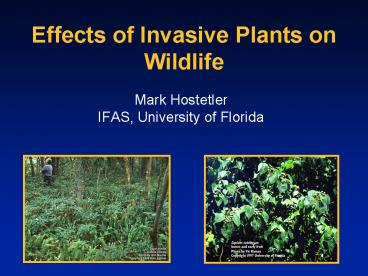Effects of Invasive Plants on Wildlife - PowerPoint PPT Presentation
1 / 48
Title:
Effects of Invasive Plants on Wildlife
Description:
Title: The Importance of Multi-Scale Analyses in Avian Habitat Selection Studies in Urban Environments. Author: Center for Environmental Studies – PowerPoint PPT presentation
Number of Views:144
Avg rating:3.0/5.0
Title: Effects of Invasive Plants on Wildlife
1
Effects of Invasive Plants on Wildlife
- Mark Hostetler
- IFAS, University of Florida
2
Overview
- Wildlife Basic Habitat Requirements
- An example about birds
- Invasive Plants
- How they disrupt wildlife habitat
- Specific examples
3
Wildlife Habitat
Photo by Joe Schaefer
4
Invasive Exotic Plant?
- An Exotic plant that is free-living and can cause
- environmental or economic damage
- Considered invasive exotic by the Invasive
Species - Working Group
- http//www.dep.state.fl.us/lands/invaspec/
5
Wildlife?
Black Bear
Katydid
Alligator
O.-crowned Warbler
Shoal Bass
Flatwoods Salamander
6
Habitat for Birds
7
FOOD
8
Insectivores
Photos courtesy of www.flwildflowers.com
9
Insect Eaters
Yellow Warbler
Great-crested Flycatcher
Hairy Woodpecker
10
Granivores
Sweet Gum Tree
Spanish Needle
11
Seed Eaters
White-crowned Sparrow
House Finch
Blue Jay
Tufted Titmouse
12
Frugivores
- Many different plant species produce fruit
- (e.g., hollies, cedar trees, beauty berries, wax
myrtles)
www.flwildflowers.com
Beautyberry
Holly spp.
13
Nectivores
Hummingbirds like to feed on plants that produce
nectar
Trumpet vine
Coral Honeysuckle
14
Fruit and Nectar Eaters
Ruby-throated Hummingbird
Northern Mockingbird
Brown Thrasher
Cedar Waxwing
15
Carnivores
16
Meat Eaters
Loggerhead Shrike
Barred Owl
Great-horned Owl
17
COVER
18
Cavities
- Snags are in
- short supply in
- some habitat
19
Primary Cavity Nesters
Pileated Woodpecker
Hairy Woodpecker
Hairy Woodpecker
20
Secondary Cavity Nesters
- Photos of owls, titmice, chickadees, etc.
Tufted Titmouse
Carolina Chickadee
Great-crested Flycatcher
Eastern Bluebird
21
Vegetation for Cover
- Safety from predators
- Some nest on the ground where there is lots of
vegetative cover
22
WATER
23
Aquatic Birds
Great Egret
Osprey
24
Space
25
Example Trees and a Bird
26
How Do Invasive Plants Affect Wildlife?
- Food
- Cover
- Water
- Space
27
Effects of Invasive Plants on Wildlife Populations
- Create monocultures of new habitat
- Alter ecological processes (e.g., fire
frequencies and intensity)
28
Air Potato(Dioscorea bulbifera)
- Covers mature trees and shades out understory
vegetation - Impact on wildlife has not been well studied
29
Australian Pine(Casuarina spp.)
- Quickly colonizes disturbed beach plant
communities - Invasions produce dense litter
- Decrease in small mammal population densities
- Affects nesting efforts of sea turtles and
American crocodiles
30
Brazilian Pepper(Schinus terebinthifolius)
- Forms dense monospecific stands
- Fewer birds nest in pepper forests
- In some cases, fewer amphibians and reptile
species were collected in pepper forests
31
Chinese Tallow(Sapium sebiferum)
- Forms dense monospecific stands
- Increase nutrient loading on aquatic systems
- Impact on wildlife has not been well studied
32
Hydrilla(Hydrilla verticillata)
- Reduces light penetration and low levels of
dissolved oxygen beneath canopy - Can shift macroinvertebrate populations
- In extreme situations, can affect growth rate of
popular game fishes - Food for some waterfowl species
33
Hydrilla
34
Old World Climbing Fern(Lygodium microphyllum)
- Dense blankets over native trees
- Insect diversity is decreased
- Impact on other wildlife has not been well studied
35
Melaleuca(Melaleuca quinquenervia)
- Extremely dense monospecific forests
- Some evidence that it causes wetlands to dry up
- Fires burn hotter in wetlands
36
Melaleuca
- Decrease in small mammal population densities (?)
- Poor forage for large vertebrates
- Some birds are benefited
- Generally, effects on wildlife not well studied
37
Torpedo Grass(Panicum repens)
- Forms extensive monospecific stands of grass
- Displaces native vegetation along shorelines
- Little value for fishes, waterfowl, or songbirds
38
Water Hyancith(Eichhornia crassipes)
- Forms dense aquatic plant canopy cover
- Low light intensities and dissolved oxygen levels
- Smothers beds of native submersed vegetation
- Can cause lower fish production
39
Spotted Knapweed(Centaurea maculosa)
- Reduced forage of elk between 50 90
40
Leafy Spurge(Euphorbia esula)
- Reduced bison forage by 83
41
Impact on Wildlife?
- Invasives change the environment (e.g., closed
canopy and dissolved oxygen levels) - Invasives replace native plants - most wildlife
cannot eat invasive plants - Disrupts food chain
42
Where to Go for Info On Wildlife?
- Web site www.wec.ufl.edu/extension
- Call your local extension office
- Call Florida Fish and Wildlife Conservation
Commission or visit www.state.fl.us/fwc
43
Where to Go For Info on Invasive Species?
- Center for Aquatic Invasive Plants
- http//plants.ifas.ufl.edu/
- Florida Exotic Pest Plant Council
- http//www.fleppc.org/
- Department of Environmental Protection
- http//www.dep.state.fl.us/lands/invaspec
44
What Can You Do?
- Remove Invasive Exotics on Your Property
- Report Invasive Exotic Plants
- Educate Your Neighbors About Invasive
- Exotic Plants
45
Summary
- Wildlife Habitat
- - Food, Cover, Water, and Space
- Not well studied, but monospecific stands of
- exotic plants do affect wildlife by replacing
- native plant communities.
- Wildlife Info www.wec.ufl.edu/extension
46
(No Transcript)
47
Acknowledgements
Developed by
Dr. Mark Hostetler, Department of
WildlifeEcology and Conservation, IFAS,
University of Florida, 2001.
48
Acknowledgements
Photo Sound Credits
Mark Hostetler, Vic Ramey, Ann Murray, and Dan
Sudia Invasive Plants Center for Aquatic
Invasive Plants USGS Patuxent Bird Center (Bird
Photos) http//www.mbr-pwrc.usgs.gov/Infocenter/i
nfocenter.html FL Museum of Natural History
http//www.flmnh.ufl.edu































